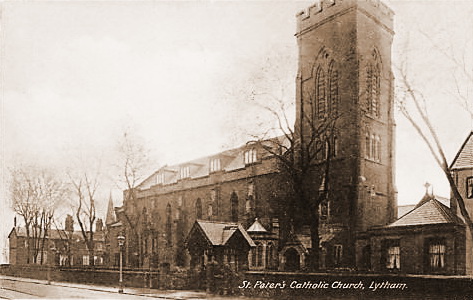St.Annes Express, October 26th, 1910
LYTHAM A CENTURY AGO.
STORY OF FYLDE CATHOLICISM.
The last issue of St. Peter's
(Lytham) "Bazaar Gazette," contained a further instalment of the history of St.
Peter's, from the pen of the Rev, Father Greaves, which is an interesting
account of the progress of local Catholicism.

Up to the year 1800 the
Catholics of Lytham and district attended Mass in the Chapel in. Lytham
Hall. As we have already seen, Mass was
said here from the year 1606, when Sir Cuthbert Clifton built the first Hall.
In the year 1800, this chapel was closed to the public. In its
place, a Tythe Barn, just outside the
Park, was fitted up as a chapel. The priest-in-charge —the Rev. Father
Pope—removed to a house close by, called the Woodlands.
For almost forty years, our
forefathers assembled in the old Tythe Barn to join in the Holy Sacrifice of
the Mass. They thought nothing of walking
long distances to Mass, and when they approached the Sacraments they prepared
themselves long beforehand with great care. Their religion was the solid,
unostentatious religion that had been tried in the fire.
We must bear in mind that the
days of persecution were only now coming
to an end. They were still feeling the effects of it. In consequence of this,
Catholicism had passed out of the life of the nation, and even out of the
knowledge of the average Englishman.
Cardinal Newman, in a striking
passage of his sermon on 'The Second
Spring,' gives us a good idea of
Catholicism at this time. No longer the Catholic Church in this country, nay,
no longer, I may say, a Catholic but a few adherents of the old religion moving
silently and sorrowfully about, as
memorials of what had been.
'The Roman Catholics'—not a
sect, not even an interest, as men conceived of it—not a body, however small,
representative of the great communion
abroad, but a mere handful of individuals who might be counted like the
pebbles and detritus of the great deluge, and
who, forsooth, merely happened to
retain a creed which, in its day, indeed, was the
profession of a Church." A new
life had now begun for the Catholics of this country. They had gone
through the fire of persecution, and had suffered for years those unjust
Penal Laws which had been passed against them.
In 1791, a Bill was
passed—almost unanimously--in both Houses of Parliament, for the relief of the
English Catholics. In consequence of this 'Toleration Act' and the Catholic
Emancipation Act of 1829, a 'great increase took place in the number of
.Catholics.
In the year 1814, there were
about 160,000 Catholics and 390 priests in this country. Twenty-five years
later, the number of priests was over 500 while the total number of Catholics
reached 400,000. This rapid increase has continued to the present time. From
what has been written, we an form some idea of the state of the Catholic Church
in Lytham about the year 1800. At this time, Lytham was a hamlet containing
several
MUD AND THATCH
COTTAGES,
interspersed here and there
with a fair number of habitations of
recent origin. There were two inns, the
What Sheaf and the Clifton Arms, beside two small licensed houses. There were
several shops in the village, and a house
of Confinement, containing separate tells for the detention and
punishment of any offender against the
law. The most pretentious dwellings stood upon the north portion of the tract, known as the
Marsh.
There was no elegant
promenade, with its expansive sward as at present, but the whole space, at one
end of which Mr. Cookson had erected a Windmill, was covered with miniature
sandhills. Two steamers plied daily between Preston and Lytham!. In the year
1801, the population of Lytham was 920 persons.
In the year 1804, the Rev.
Thomas Dawson took charge of the Mission at Lytham. Owing to his weak health,
he was assisted by the Rev. John Lawson. From a pamphlet printed in Liverpool
in 1819, on Catholic Chaplains, with their respective congregations, we find the number of Catholics in
Lytham and Lancashire.
The Hundred of West Derby
(including Liverpool and Wigan) had a Catholic population of 33,200. Salford Hundred had 15,880, and the Hundred
of Amounderness had a Catholic population of 12,650. Of these, Preston, with
two chapels and four priests, had 6,000 people, and Lytham had a congregation of 500 people.
During these years, Lytham
made steady progress. Buildings of modern
and pretty design sprang up along the Beach, while others were erected in
Clifton Street. During the summer months hundreds of day visitors found their
way in carts, waggons and lighter vehicles to the coast of Lytham. They came
from Preston, Blackburn, Burnley, and other inland towns. The following is a
description of the attractions of Lytham in the year 1821.
"Lytham is a very
salubrious place; its walks are pleasant and diversified. You may walk for
miles on the sand westwards. You may trip to the Hey-houses and get bad ale.
Commonside offers a journey, which,. if you please, ends at Blackpool. The
walks are many and various for those who love exercise. The lazy will soon tire
here, but the actives will never be at a loss. The sands are fine—the sea
breeze pleasant —the air is impregnated with
health."
At this time the population of
Lytham amounted to 1,292 persons, consisting of 258 families. As we have
already seen, the number of Catholics attending the Chapel in the old Tythe
Barn was at this time 500. For 25 years, Father Dawson and Father Lawson
laboured among the Lytham people. In the year 1829, they were transferred to the mission at Croston. They
were succeeded at Lytham by the Rev. Joseph Walmsley.
|